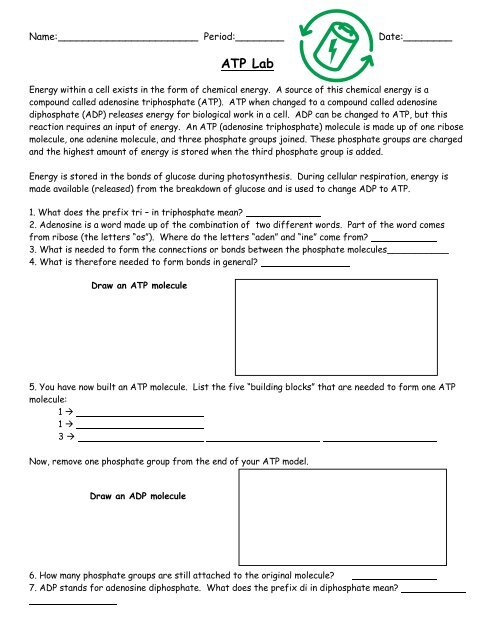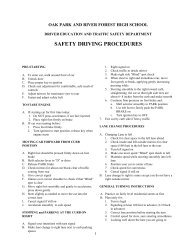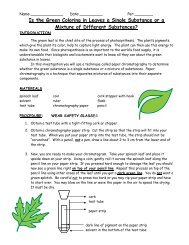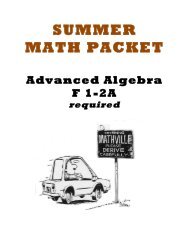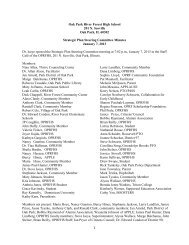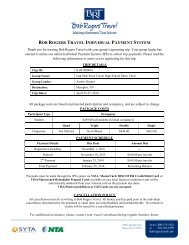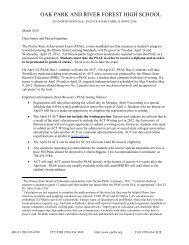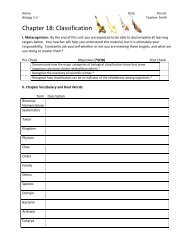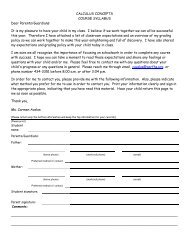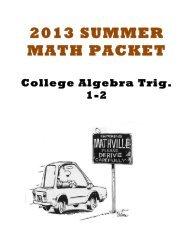ATP Lab
ATP Lab
ATP Lab
Create successful ePaper yourself
Turn your PDF publications into a flip-book with our unique Google optimized e-Paper software.
Name: _______________________ Period:________<br />
Date:________<br />
<strong>ATP</strong> <strong>Lab</strong><br />
Energy within a cell exists in the form of chemical energy. A source of this chemical energy is a<br />
compound called adenosine triphosphate (<strong>ATP</strong>). <strong>ATP</strong> when changed to a compound called adenosine<br />
diphosphate (ADP) releases energy for biological work in a cell. ADP can be changed to <strong>ATP</strong>, but this<br />
reaction requires an input of energy. An <strong>ATP</strong> (adenosine triphosphate) molecule is made up of one ribose<br />
molecule, one adenine molecule, and three phosphate groups joined. These phosphate groups are charged<br />
and the highest amount of energy is stored when the third phosphate group is added.<br />
Energy is stored in the bonds of glucose during photosynthesis. During cellular respiration, energy is<br />
made available (released) from the breakdown of glucose and is used to change ADP to <strong>ATP</strong>.<br />
1. What does the prefix tri – in triphosphate mean?<br />
2. Adenosine is a word made up of the combination of two different words. Part of the word comes<br />
from ribose (the letters “os”). Where do the letters “aden” and “ine” come from?<br />
3. What is needed to form the connections or bonds between the phosphate molecules___________<br />
4. What is therefore needed to form bonds in general?<br />
Draw an <strong>ATP</strong> molecule<br />
5. You have now built an <strong>ATP</strong> molecule. List the five “building blocks” that are needed to form one <strong>ATP</strong><br />
molecule:<br />
1 <br />
1 <br />
3 <br />
Now, remove one phosphate group from the end of your <strong>ATP</strong> model.<br />
Draw an ADP molecule<br />
6. How many phosphate groups are still attached to the original molecule?<br />
7. ADP stands for adenosine diphosphate. What does the prefix di in diphosphate mean?
8. List the four “building blocks” that are needed to form one ADP molecule:<br />
1 <br />
1 <br />
2 <br />
9. When the phosphate group was removed from <strong>ATP</strong> to make ADP, what else was released?<br />
10. Therefore, what happens when bonds break?<br />
11. Look at the following equation:<br />
<strong>ATP</strong> ADP + P + E<br />
a. What do you believe the P stands for?<br />
b. What do you believe the E stands for?<br />
12. What do the cells do with the energy that is released during the formation of ADP? (hint: look at the<br />
beginning of the lab)<br />
13. After the energy in a molecule of <strong>ATP</strong> is used, the cell is left with a molecule of ADP and a phosphate<br />
group (P). What will happen to these molecules?<br />
14. What is required to rejoin the ADP and the P molecules?<br />
15. <strong>ATP</strong> and ADP function much like batteries that store energy, until the cell needs it. If ADP can be<br />
compared to an uncharged battery, to what would <strong>ATP</strong> be compared?<br />
ADP : uncharged battery, <strong>ATP</strong> :<br />
16. The term that means the adding of a phosphate group to a molecule is?<br />
17. During what process is energy stored in the bonds of glucose?<br />
18. During what process is the glucose broken down to release its stored energy?<br />
19. What type of organism can make their own food? (autotroph or<br />
heterotroph?)<br />
20. What type of organism cannot make their own food and must obtain energy from the food they eat?<br />
(autotroph or heterotroph?)<br />
Use each of the terms below just once to complete the passage:<br />
energy phosphate adenine charged<br />
<strong>ATP</strong> chemical bonds work ribose<br />
To do biological<br />
, cells require energy. A quick source of energy that cells use<br />
is the molecule . The in this molecule is store in its<br />
. <strong>ATP</strong> is composed of a(n) molecule bonded to a(n)<br />
sugar. Three molecules called groups are<br />
attached to the sugar.


